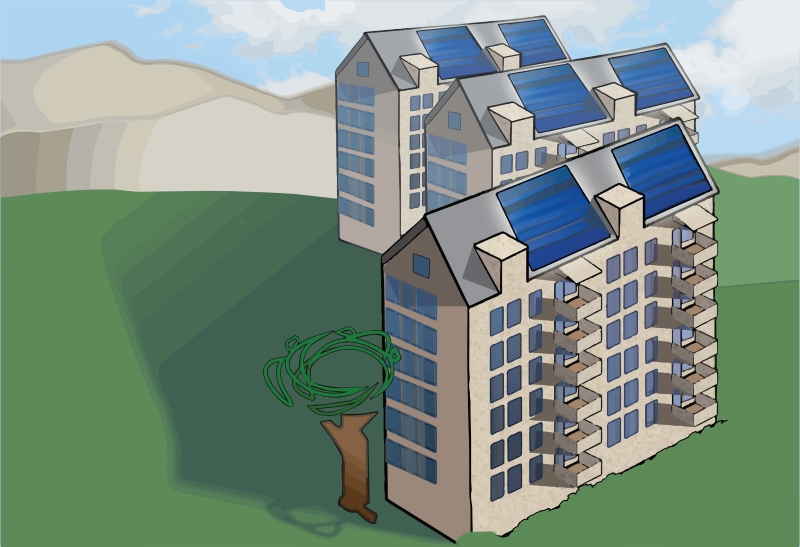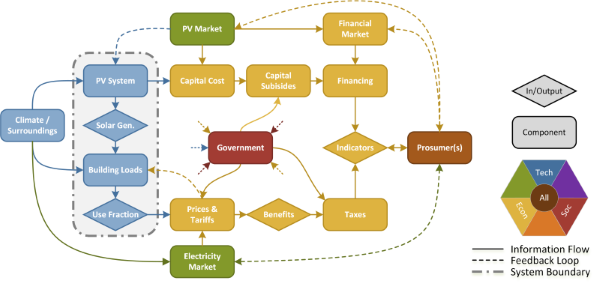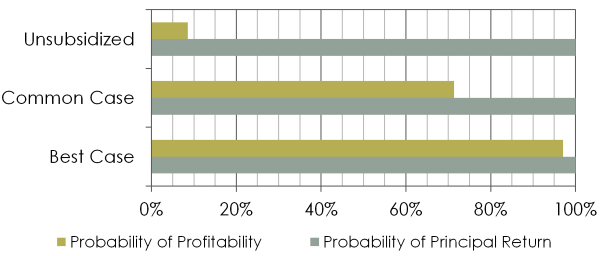Solar photovoltaic systems in Swedish cooperative housing (completed)
Rapid declines in the cost of solar photovoltaic modules have made rooftop mounted systems economically interesting in Sweden, especially large scale systems for multi-family housing. This project seeks to understand how solar PV can technically and economically integrate into the residential cooperative's energy system.

Introduction
Sweden is well known for its leadership in sustainability and energy system transformation; however solar photovoltaics (PV) have typically been left out. Rapidly decreasing PV system prices have made rooftop mounted systems increasingly interesting for residential buildings, where consumers can also be producers; also known as prosumers. Multi-family dwellings are particularly interesting due to their large roofspaces, making it possible to install commercial sized systems which often have lower installation costs than single family house systems.
Objective
This project seeks to develop knowledge surrounding the applicability of solar PV systems in Swedish multi-family housing. Because this work is closely tied with real-world applicaitons, the constraints on appropriate technologies is largely economic. Therefore the primary objective is to identify the most cost-effective PV systems under relevant policy scenarios and effectively relay the results to the boards of directors of cooperatives across Sweden.
Methodology
The rapidly transforming solar PV and electricity markets, plus PV related energy policy, can make it difficult to effectively assess a PV investment. This is combined with the degregulated electricity markets, which also create high levels of uncertainty, particularly in the long term. Therefore an analysis methodology which can handle uncertainty and provide a measurement of risk and reward is saught. To aid in this process, inputs from experts from industry, government, and academia are consulted to help identify potential development paths in the electricity system.

In a relatively new market where there are many "first movers", it is important to learn from the experiences of others. Partnership with Riksbyggen has made it possible to conduct interviews with cooperative boards from around Sweden who have already installed PV and some who are interested. A before and after perspective is available from those who have installed, and from all cases can energy usage and production data be collected and used to better the investment analyses.
Approach
After a comprehensive review of investment analysis techniques, was chosen as the preferred approach for this project. Monte Carlo makes it possible to incorporate the random fluctuations in the real world such that the liklihood of a given outcome can be quantified, for example; the profitability of a PV investment in Sweden. The main analysis is done using three policy scenarios; completely unsubsidized, a predicted "most-likely" or common case, and a best possible case.
Results
For a well-positioned (i.e. south facing) roof in mid- to southern Sweden, the current policy support offered by the government will lead to a 70% chance of earning a 3% real return on investment (i.e. profitability). If there is no support, the probability falls to 8%. In all cases there is effectively no risk for loss of the original investment (i.e. principle), meaning even if the targeted 3% is not earned the investment should still have a positive return. The investment recovery time is still long, with the simple and discounted payback times in the common case being 18 and 25 years, respectively.

Conclusions
The primary conclusion from these studies is that solar PV is a good investment for Swedish cooperatives with roofs well positioned for solar. However, the investment must be considered long term, much like a new roof or windows. It can also be concluded that for the continued near-term growth of the market, direct support policy from the government will be necessary. Future work will use this method to focus on building energy systems integration for solar PV which can mitigate risks and maintain necessary cash flows in a dynamic marketplace.
Final Reports
Solceller ur flera perspektiv: Handbok för beslutfattare
Public Seminar
A public seminar with over 70 attendees was held on on April 14th presenting the results and conclusions from the project at KTH Open Lab. You can watch all of the presentations in the video link below as well as download the slides.
Investment Calculation Tool
All of the results generated were created with a custom Excel-based calculator, which is available for download. All equations describing the calculation methodology are included as well as instructions on how to use it. Important note: the file has several macros for performing calculations, which may be blocked depending on your Microsoft Excel security settings.
Final preparations are being made - Please check back soon!
Academic Publications
Sommerfeldt N, Madani H. Revisiting the techno-economic analysis process for building-mounted, grid-connected solar photovoltaic systems: Part one – Review. Renewable & Sustainable Energy Reviews 2017; vol. 74, pp. 1379-1393
Sommerfeldt N, Madani H. Revisiting the techno-economic analysis process for building-mounted, grid-connected solar photovoltaic systems: Part two – Application. Renewable & Sustainable Energy Reviews 2017; vol. 74, pp. 1394-1404 .
Sommerfeldt N. On the economic effects of metering schemes in community owned residential PV systems. Solar World Congress 2015; Daegu, South Korea.
Sommerfeldt N., Muyingo H. Lessons in community owned PV from Swedish multi-family housing cooperatives. 31st European Photovoltaic Solar Energy Conference and Exhibition; 2015; Hamburg.
Sommerfeldt N., Madani H. On the use of hourly pricing in techno-economic analyses for solar photovoltaic systems. Energy Conversion and Management, 2015; 102, 180-189
Sommerfeldt N., Madani H. Improved methodology for determining the value of energy from distributed renewables using statistical analysis combined with normative scenarios. International Conference on Applied Energy 2014. Energy Procedia;61;1089-1092.
Sommerfeldt N. Opportunities for large scale solar photovoltiac systems in Swedish multi-family housing. 3rd International Workshop on Integration of Solar Power into Power Systems; 2013; London; Energynautics Gbmh. ISBN 978-3-9813870-8-7
Popular Science Publications
Granmar M., Ny forskning: Behåll solelen själv. Energi & Miljö, 3/2015, page 25.
Contact
Funding
Funding is provoded by the Swedish Research Council Formas (no. 2012-256).
Partners
